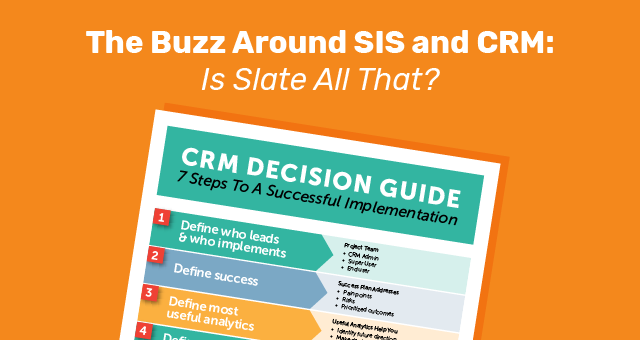
Prime recruiting season is upon us. So much to do.
Important questions:
- Do you maximize your relationships and connections with potential students—getting to know them and customizing their interactions with your university?
- Once they show up on campus, how do you manage your communication with them and manage their data?
- How about once they graduate?
These questions have led to $3.26 billion in new EdTech investments and apparently cult followings. What is the shared answer?
Well, the answer has a lot to do with technology and a whole lot to do with people. Intead Plus members have access to our Essential Guide to Academic CRM’s – a terrific and streamlined CRM implementation guide with a heavy focus on the people part.
And once you’ve got the people part down, is the rest of the answer really Slate?
We have a fair amount to say on this topic, as you might imagine. We’ve streamlined it to a 3-5 min read. Join us…
What can bring you closer to prospective students and provide them with a more personal admissions process, while oddly enough placing a computer system between you?
Which hot tickets are revolutionizing the way admissions offices do their work using Student Information Systems (SIS) and Customer Relationship Management (CRM) services and software?
A quick refresher: These systems act like a concierge. For the student, they learn about student preferences and interests, giving suggestions, and answering their questions; while for a university, they are automating data management grunt work—both of which increase student satisfaction, success, and retention.
And if you are thinking about the data that is all important to strengthening your recruitment program, you’ll want to consider our pre-conference workshop at the AIRC conference this December (scroll down to see the link to pre-conference workshops here: AIRC Annual Conference).
Many of the primary SIS and CRM options have been in the industry for a long time; some are relatively new to the field:
- Campus Management
- Jenzibar
- Ellucian
- Hobsons
- Salesforce
- PeopleSoft
- Workday Student
- Slate
Some of these have been the bane of our existence as academic administrators (we’re glaring at you Banner) and others are coming to our rescue (we’re kvelling at you Slate).
Slate, created by Technolutions, Inc., is a software system that is taking a lot of tedious monotony out of admissions staffs’ daily grind, and these departments can’t stop spreading the good news.

Ben and Technolutions founder and CEO Alexander Clark at NACAC 2018. Important Note: Intead has nothing more than a collegial relationship with the folks at Technolutions.
Slate isn’t just a database that stores information, or even one that can quickly calculate reports with percentages and summaries—though it does that—it provides customized information and predictive modeling about students’ behaviors and interests and tells an admissions department what to do next. Who wouldn’t want Magic 8-Ball software for their job?
Other SIS/CRM platforms perform many of the same functions, but user experience here is key. When your CTO and your admissions reps are both using a system and singing its praises – the folks who created it hit the right note. Slate is singing that song. And this is a difficult crowd to please.
Eric Hoover (@erichoov) from The Chronicle of Higher Education said of the summit: “Though most conferences cause drowsiness, this one stokes wonder and wide-eyed belief—belief in Clark’s growing empire. Forget his official title: CEO of Technolutions Inc. Among users of Slate, his uberpopular software system, Clark is a guru, a legend. One fan calls him ‘the Wizard of Oz for geeks.’ His product is a fast-growing giant. It has changed the way admissions offices mine data, make decisions, and communicate with students. And it has spawned a subculture some members lovingly call a cult.”
So, how exactly is Slate being used by 950+ colleges and universities?
- Communications
With Slate, an admissions office can send emails, text messages, or letters, as well as set up custom alerts and reminders for deadlines or decisions. It can easily sort students for these communications by program, geographic location, interest, etc.
This is a feature getting some heavy use. In 2017 alone, Slate transmitted 7 million text messages and 1.6 billion emails. Other platforms are doing the same.
- Contact Management
Slate tracks prospective students with their contact information, intended field of study, term entrance, and interactions with administration. In terms of their communications interactions, Slate tracks whether emails from the school are opened and read and how long afterwards a student chooses to go to the school website and which pages on it they view and for how long. Most current platforms will perform these functions as well.
- Online Applications
Slate creates the online application for a college or university and then manages the uploading process. In 2017, Slate uploaded 8.5 million new application. That’s a lot of uploading and lot of time saved from going through paper applications. Yes, some institutions still process paper. Many other platforms will do this or integrate with another online application system.
This is important: Tracking student interactions from initial contact through application submission and beyond is far harder than most administrators think. Having it all in one platform is superior and will lead to much stronger analytics. Which in turn lead to stronger yields as you adjust your marketing based on accurate data.
- Online Reading
Slate can be harnessed to help you manage application review processes for collaborative evaluation within a department or committee by allowing comments, recommendations, and ratings. Again, having this process in the one platform as opposed to stitching together various platforms offers a better overall process (more efficiency and better tracking) for enrollment/admissions administrators and staff.
- Event Registration and Forms
You can use Slate to gather registration information, create an event check-in, and set up event- or acceptance-communication portals. Slate will even provide students with embedded event weather forecasts in their received communications. It also gives students options for customizing their campus visits—beyond choosing a date and time—such as selecting a class to attend or faculty member to visit.
- Custom Reporting and Queries
Reports can be created and dispersed through Slate, such as data by program, student matriculation rates, class profiles, year-over-year reports, and admitted student summaries. There are numerous possibilities for sorting and grouping students, as Slate can also manufacture lists of students based on their high school grade point averages, extracurricular activities, those with siblings still in high school, and those who share a guidance counselor (to whom Slate also provides a free service through Slate.org to keep admissions offices and counselors on the same page with a conduit for sharing data).
Again, when all the tracking is in one platform from initial inquiry through application and acceptance, the reporting is far stronger. The insights here help you build a stronger enrollment system over time.
- Payment Processing
Slate offers Payment Card Industry Data Security Standard-compliant processing for application/registration fees and deposits.
- Giving
Slate has an optional giving module for gift management that tracks one-time and recurring gifts, pledges, planned gifts, in-kind contributions, scholarships, and proposals.
This certainly isn’t an exhaustive list, and even if it were, it wouldn’t be accurate for long. Slate is continuing to up the ante. Last year, one hundred new features were added after asking customers what they wanted to see—all without a price hike.
Integration
Integration is also key with Slate, as they promise to seamlessly integrate with other student information systems, common application services, standardized testing data files, student search lists, document management systems, and other campus/alumni systems. And frankly, all systems make this promise. Most struggle to deliver on it. And that is likely true here as well. Integrating systems is never as easy as the sales team likes to tell you it is.
Still, the university CTOs we’ve talked to love Slate and let’s be honest, CTOs don’t love much.
One of the downsides to the frenzied attraction to Slate is that as the list of higher education customers grows, so has the wait for some technical fixes and the demands on customer support.
Adding new features is all well and good. Helping the admissions office learn how to best harness them, that’s another thing. Too many options for streamlining the admissions process seems like a good problem to have, though.
Implementation
Adding a new technology tool (SIS, CRM, etc.) is a headache no matter how you slice it. This is work that has to come on top of everything else you need to get done as an institution. So many of these new tools arrive with fanfare and never get off the ground. Or the staff training is an afterthought and the advantages never materialize – because no one is using it!
Or they are not using it well: features left out, data not being entered, data not being used for continuous process improvement.
This is where our CRM Decision Guide is helpful as a planning tool as you move forward.
Though there will always be a learning curve, the more intuitive the software is, the more those in admissions without an IT degree are able to leverage the platform and improve results.
Still, many admissions offices are choosing to have employees whose only job is to manage Slate or the like, and some in admissions have said that having at least one officemate with SQL programming knowledge can be helpful in unlocking all of the platform features.
Stuff you know you will underestimate:
- Time to install – These tools take time to install and implement, especially when there is a change over from another platform. It will take a while to get this up and running unless you have a dedicated project manager or two or three.
- Time to populate – Your recruitment engine will only be as good as the content you plug into it. Creating a compelling, well-segmented library of nurturing emails will take time as well.
- Time to review the analytics – your new CRM will provide you with great reporting as long as you have someone charged with pulling and analyzing the data. Devoting this talent and time is well worth it. Those that do this succeed by design. Those that don’t typically fail. If they succeed, it is based on luck.
Let’s put the necessary resources in place and make the platform do more of the work for us. The results will speak for themselves – with a little internal promotion from you!


